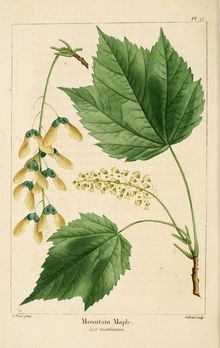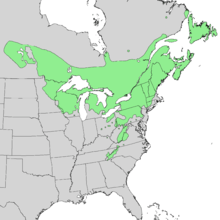Acer spicatum
Acer spicatum (mountain maple), also known as dwarf maple, moose maple, and white maple, is a species of maple native to northeastern North America from Saskatchewan to Newfoundland, and south to Pennsylvania. It also grows at high elevations in the southern Appalachian Mountains to northern Georgia.[3]
| Mountain maple | |
|---|---|
 | |
| 1819 illustration[1] | |
| Scientific classification | |
| Kingdom: | |
| (unranked): | |
| (unranked): | |
| (unranked): | |
| Order: | |
| Family: | |
| Genus: | |
| Species: | A. spicatum |
| Binomial name | |
| Acer spicatum Lam. 1786 | |
 | |
| Generalized natural range | |
| Synonyms | |
|
List
| |
Description
Acer spicatum is a deciduous shrub or small tree growing to 3–8 m (10–25 ft) tall, forming a spreading crown with a short trunk and slender branches. The leaves are opposite and simple, 6–10 cm (2 1⁄4–4 in) long and wide, with 3 or 5 shallow broad lobes. They are coarsely and irregularly toothed with a light green hairless surface and a finely hairy underside. The leaves turn brilliant yellow to red in autumn, and are on slender stalks usually longer than the blade. The bark is thin, dull gray-brown, and smooth at first but becoming slightly scaly. The fruit is a paired reddish samara, 2–3 cm (3⁄4–1 1⁄4 in) long, maturing in late summer to early autumn.[4]
 Flowering tree
Flowering tree Fruits (samaras) with measurement for scale
Fruits (samaras) with measurement for scale
Distribution and ecology
The tree lives in moist woods in rich, well-drained soils on rocky hillsides and along streams. It also grows on ravines, cliff faces, and forested bogs. It colonizes the understory of hardwood forests.[5]
Mammals such as moose, deer, beavers, and rabbits browse the bark; ruffed grouse eat the buds.[5]
Uses
The sap is a source of sugar and can be boiled to make maple syrup. The bark contains tannins, which are used in tanning leather. Indigenous peoples infused the piths of young twigs to produce treatments for eye irritation and made poultices from boiled root chips. It is also said to be used to relieve stress in humans.[6]
References
- 1819 illustration. Source The North American sylva, or A description of the forest trees of the United States, Canada and Nova Scotia ... to which is added a description of the most useful of the European forest trees ... Translated from the French of F. Andrew Michaux.
- "Acer spicatum". IUCN Red List of Threatened Species. 2019. 2019. Retrieved 17 June 2019.CS1 maint: ref=harv (link)
- "Acer spicatum". County-level distribution map from the North American Plant Atlas (NAPA). Biota of North America Program (BONAP). 2014. Retrieved 3 September 2016.
- Rook, Earl J.S. (2002). "Moose Maple, Acer spicatum". Shrubs of the Northwoods. Archived from the original on November 27, 2005.
- Little, Elbert L. (1980). The Audubon Society Field Guide to North American Trees: Eastern Region. New York: Knopf. p. 581. ISBN 0-394-50760-6.
- "Acer spicatum". Plants for a Future.
External links
- Common Shrub Species of the Northwest Forest, Acer spicatum Mountain Maple, White Maple
- Acer spicatum images from Vanderbilt University
- Portrait of the Earth, Winter ID pictures
- Interactive Distribution Map of Acer spicatum
| Wikimedia Commons has media related to Acer spicatum. |
